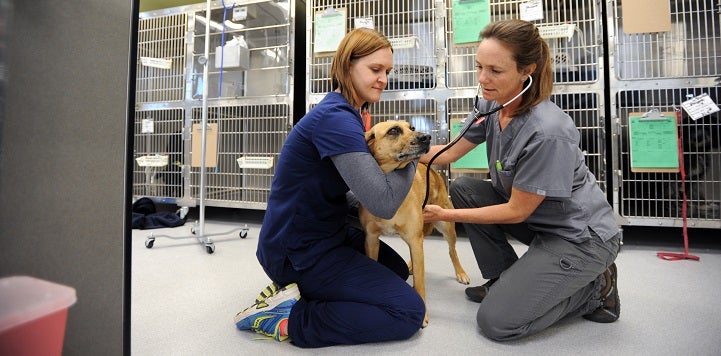
The State of Access to Veterinary Services Today – An Interview with Aimee St. Arnaud
Over the next two weeks we will be talking to Aimee St. Arnaud about the current situation regarding access to veterinary care and some suggested ways that shelters and rescue partners can overcome today’s challenges. Aimee has spent 20 years in the industry, working for such organizations as Best Friends, HSUS, ASPCA and PetSmart Charities.

Aimee is a business partner in two full-service veterinary clinics (Community Pet Care Clinic in Ohio and Open Door Veterinary Care in North Carolina) that focus on removing barriers to care and increasing access to veterinary services while still maintaining a net positive revenue. She recently created a non-profit mentorship training called Open Door Veterinary Collective for clinics that want to replicate their business model, including giving back through their revenue, providing incremental care and creating strong community partnerships with human social service and animal non-profits.
Liz Finch: First, I think you’ll be pleased to hear that, based on our website analytics, the spay/neuter stimulus piece you wrote last June is still one of our most popular program spotlights!
Aimee St. Arnaud: Most definitely - I’m so excited that is still top of mind!
That’s probably not so surprising, both because spay/neuter is always of interest to our partners and because of the current situation with challenges to getting adequate access to vet care.
It absolutely makes sense that spay/neuter would be top of mind for shelters and rescues trying to move their animals out into adoptive homes or to support community cat efforts. The pause we had to take during COVID has led to pent-up demand and a massive backlog for those surgeries.
Shelters all over the country are having trouble fixing their animals and I regularly hear clinics are booked four months out. Even areas like the Northeast, which traditionally take in transports from other areas of the country, are now full themselves with animals in need and they are also backed up on their surgeries.
I know this impacts all animals, but I’m personally active in TNVR and have had a really hard time getting spay/neuter appointments for cats.
I think cats have been impacted the most by the demand for spay/neuter surgeries and RTF and TNVR programs aren’t getting as much support as they used to. Because they can’t keep up with the demand, clinics have been putting more barriers in place for people doing this work, like requiring appointments instead of being able to take in walk-ins on set community cat days. They are also limiting the number of cats you can bring in and cutting the number of surgeries they can offer to shelter partners.
Of course, spay/neuter access is just one part of the current “state of the state” when it comes to veterinary resources, right?
There is pent-up demand for all kinds of vet services, yes, but we have also been experiencing a shortage of vets and vet techs for the past several years. Even when we do get “caught up” on the services that have been delayed this past year and a half, we will still be facing a staffing shortage that is desperately crippling all aspects of the sector.
Especially in shelters, I’m seeing veterinary positions going unfilled for years at a time, and that’s a problem with no easy solution and no end in sight.
Yes, I did a little research on that and found some disconcerting data. The American Veterinary Medical Association (AVMA) found that, between January 2019 and May 2021, there were 18 positions open for every veterinarian seeking a job, six for every technician and assistant, and 12 for related positions.
Retention is a big issue, too. The average turnover for veterinarians is not only twice as high as it is for physicians, and vet techs have one of the highest turnovers of all health care positions.
And 90% of veterinary professionals are white, so we aren’t even attracting talent from Black, Indigenous, Latinx and other backgrounds that could expand on the number of vets looking for work.
Another thing that is making things so challenging for shelters and nonprofits is that they can’t afford to offer vet staff the same kind of salaries and benefits they can get from private practice clinics or corporate clinic structures. That shrinks the pool of applicants even more—so does the fact that only certain vets are interested in practicing shelter medicine or doing high-volume spay/neuter surgeries all day.
Speaking of which, I know that nonprofit spay/neuter clinics are your real passion, not just because of their intrinsic value but because such clinics are a gateway to accessing other components of veterinary care.
We’ve known for some time that most pets seen by spay/neuter clinics do not receive regular vet care, and that presents a great opportunity to be the first connection and refer clients elsewhere for other types of services.
However, some organizations whose mission is high-volume spay/neuter are instead adding services like wellness, euthanasia and urgent care. I've seen some clinics cut down from five days a week spay/neuter to only two or three because they've opened wellness clinics.
Are they doing that so they can attract more vets?
They’re looking for additional revenue because grant funding is trending away from spay/neuter and focusing on access to care as an emerging need. In fact, on September 22nd, I am participating in a webinar on Spay/Neuter: Integral to Access to Care for members of the Association for Animal Welfare Advancement. That came together because we are hearing from so many clinics concerned that spay/neuter is no longer being seen as critical and that is reflected in decreased funding.
As such clinics chase revenue to support spay/neuter work, however, they are actually reducing spay/neuter capacity. You also can’t simply add services without making sure you have the right equipment, treatment spaces and appropriate staff in place.
Which brings us back to the issue of staffing shortages again.
Yes. A lot of organizations are vying for the attention of those relatively few vets looking for work, and I did another webinar recently that covered everything from the best places to post listings to how to craft honest but enticing job descriptions to tips on retaining those hires once you make them.
But there are some short-term strategies that shelters and nonprofits who employ a vet staff can use right now, as well. That includes fully utilizing the techs they do have on staff, many of whom report they aren’t using all the skills they were trained on. If you haven’t done a deep dive with your techs to see their breadth of skills versus what they are doing on the job, now’s the time.
Techs can also cover some telemedicine services, which you might want to offer to fosters to slow the trend of them rushing their animals into your clinic or to emergency clinics for every issue that pops up.
More long-term, the industry is starting to mirror human medicine by creating a level of skilled veterinary professional between a tech and a fully accredited veterinarian. For instance, Lincoln Memorial University in Tennessee is launching a pilot Veterinary Clinical Care master’s program in January. The program will be online and covers medical training, clinical care training and management and communications skills. Discussions are also underway to include a shelter track, which would be great for our industry.
And of course, the industry recognizes that we need more vet schools and larger class sizes to try and cover the gap that exists between supply and demand.
So, at this point I think everyone is ready to hear some actionable things they can do to ensure communities are getting the services they need—which makes this a perfect place to stop and tease the second half of our interview next week!
Can’t wait!
Next week, we’ll talk with Aimee about some creative ways that animal welfare organizations can work collaboratively with clinics and social service agencies to bridge the gap in accessing veterinary care even during these resource-strapped times.
Read part two of our interview with Aimee here.

Liz Finch
Senior Writer
Best Friends Network
If you enjoyed this editorial, you can find our complete catalog of editorials here.